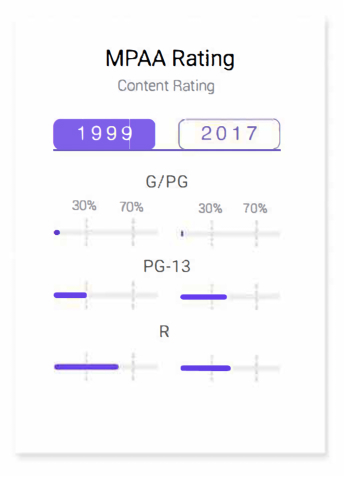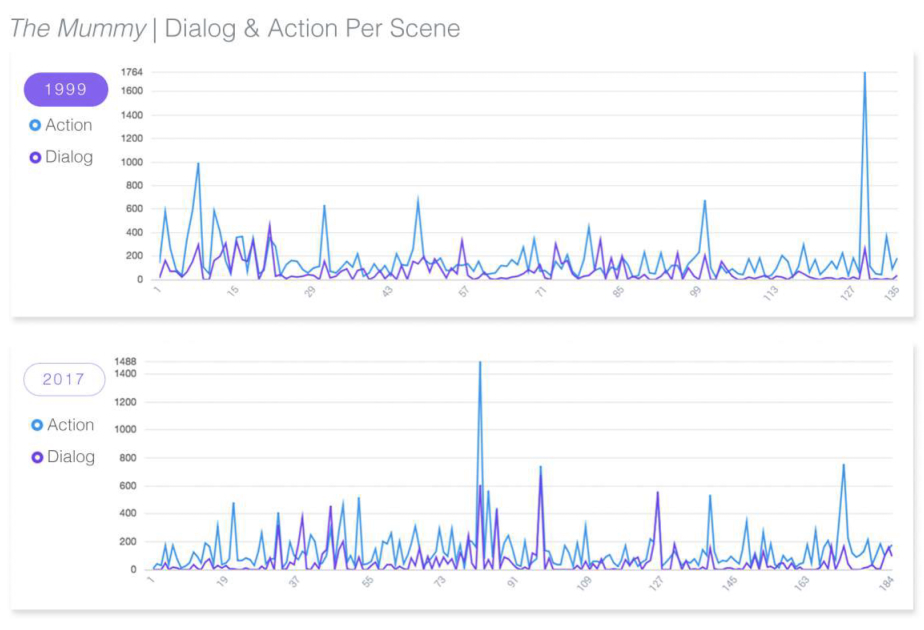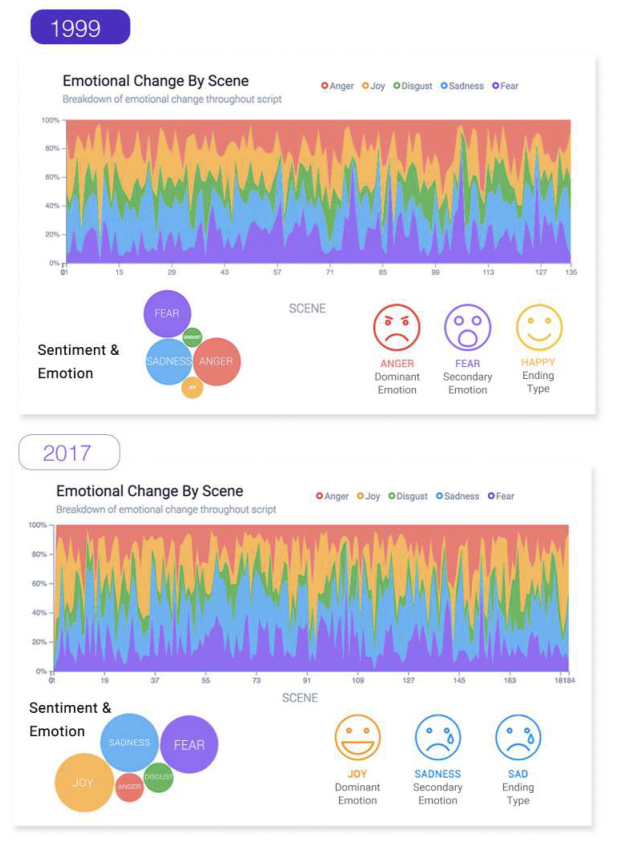Case Study: The Mummy and The Mummy Returns, one a hit and one a flop.
Posted: April 13, 2020 | Updated: April 20, 2023
Posted In: AI, Articles, Case Studies, White Papers
Artificial Intelligence Gives Studio Executives Predictive Analytics to Make Data-Driven Decisions
In this case study, we used our AI-powered story research platform to compare and contrast key elements of the original 1999 movie, “The Mummy,” a box office darling, with its 2017 sequel that didn’t share the same fate.
The Hunt for the Right Script
Financial Resources aren’t the only thing on the line when you champion a new script: reputations are at stake. A win means not only critical acclaim, but box office gold and an attractive return on investment. A box office flop, on the other hand, can spark a social media firestorm that damages you and the brand. Choosing the right script has traditionally been based on a combination of creative judgment and experience, intuition, science and, of course, luck. With movie budgets skyrocketing and theater attendance decreasing, studios must be smart and move quickly. They can reinforce their industry know-how with data, predictive analytics in particular, that computers are more adept at providing than humans.
Enter artificial intelligence (Al) to the scene: a hero character that can apply data science at breakneck speed to the wonderful, ephemeral world of screenplays and movies.
Al Transforms Assumptions into Insights
In all movie genres, there are general and specific, obvious and subtle script commonalities that serve as powerful indicators as to whether a movie has more potential to be well-received or panned. Every past script contains elements or ratios of elements that have contributed to its success or failure.
Until Al, this information was out there but untapped. It was virtually impossible to draw conclusions from such a large data set or make apples-to-apples comparisons between past and current scripts.
Al has the unique ability to rapidly compare numerous key data points within a script, such as structure, style and sentiment, with those in thousands of past scripts to find both commonalities and differences. This information may not deliver obvious answers to difficult questions, but it does provide executives with additional tools and insights into which scripts may have more box office potential.
StoryFit Brings Clarity
StoryFit is all about partnering with studios to make them more successful. We leverage Al to give them the data they need, now more than ever, to make informed decisions. With the help of Al, we are able to dig deeper into the data than ever before. When executives combine our data with their intimate knowledge of the industry, that’s when the real magic happens.
Whether it’s choosing the right script for the right audience at the right time, or editing a script to increase the odds that the movie will be a box office smash, studios must have not only their own intuition but the power of big data at their fingertips. They need to understand their audience at a micro-level and emotionally connect with them. What do viewers prefer today? What elements make scripts a hit and which are more common with a flop? When studios leverage Al-driven data as another tool in their repertoire, every detail of a script can be used as an indicator, a clue, as to whether a script is worth the investment. They can decide whether the risk of going against the grain is a wise plan to stand out or just an oversight. Either way, they’ll have all of the pieces of the puzzle to make that decision.
“The Mummy” Example
As an example of how Storyfit analytics work, we compared and contrasted key elements of the original 1999 movie, “The Mummy,” a box office darling, with its 2017 sequel that didn’t share the same fate. While the script and characters have many similarities, there were stark differences as well, and are perhaps the most telling as to why one version garnered more success.
The Breakdown
Rating
Both versions of The Mummy were rated PG-13, yet our analytics show the 1999 version displayed significantly more A-rating qualities than a typical PG-13 movie such as the 2017 version.
COMMENTARY
The 2017 movie omitted much of the gore and violence from the original movie. Perhaps as action movies have progressed over the past few decades, the audience has grown accustomed to the violence in many box office hits. Toning down the violence may suit younger viewers, but disappoint the original fans who expected it.

Structure
The 1999 The Mummy was 72% action vs. 28% dialog. The 2017 movie was nearly identical. The difference was the action and dialog was distributed differently in each movie.
COMMENTARY
When we look at both movies side-by-side, we see the 1999 version told the story through dialogue in the first 35 scenes, bringing the audience up to speed quickly and engaging them in the critical introduction phase. The climax of action came at the end of the movie with very little dialogue, very typical of successful action movies.

By contrast, the 2017 movie had little dialog or action until the midpoint of the movie, using imagery to tell the introduction of the story. The climax of the action came in the middle of the movie with more dialogue at the end of the movie for a slower finish. In action movies, history shows us that the audience enjoys the buildup and then the intense, adrenaline-invoking action at the end of a movie.
Sentiment & Emotion
For the 1999 The Mummy, the dominant emotions are anger, fear, and sadness, but an ending type of happy. The 2017 movie inspired joy as its dominant emotion with sadness and fear nearly equal, and the ending type as sad characters, 41 minor characters, and 45 total characters.
COMMENTARY
For action movies, anger and fear are quite rare emotions. The vast majority have joy and sadness. The 1999 movie was dark and scary with a happy ending where the audience was taken on an intense ride and because of the happy, completed story ending, left the movie with a sense of accomplishment and satisfaction. Happy endings are correlated with success in action movies.
Joy and sadness have become so common in action movies, perhaps the 2017 version simply didn’t stand out for the audience. They’ve been on that ride before. They left the theater feeling sad with an ending that was ambiguous, foreboding, and with less resolution.

Breakdown of emotional change throughout the script
Anger, Joy, Disgust, Sadness, & Fear
1999 vs 2017 versions
Character Numbers
The 1999 movie had 4 major characters, 18 minor characters and 22 total characters. The 2017 version had 4 major characters, 41 minor characters and 45 total characters.
COMMENTARY
The additional minor characters can be more distracting to viewers, with more crowd scenes and fewer individuals to focus on and become engaged with. Additionally, doubling the number of characters can be confusing and is more common in less successful movies.

Make Better Decisions
These are but a few of the script elements StoryFit Al compares. Our reports are interactive, giving studio executives better insights about the script and ways the script may have been changed – while also appreciating the data deserves human massaging and interpretation. We continually work with studios to bring them the data points they need, those that offer them deeper insight into a script, its characters and the audience.
The Al analytics don’t provide all of the answers, but can serve as a valuable tool to determine whether or not a script is the right one. Executives can use the data to ask questions that spark conversations, like, “Why do we only have 32 percent dialogue when most successful action movies have closer to 45 percent? Did we want the ending to be sad?”
Just because the majority of successful action movies end on a higher note doesn’t mean every action script must as well. There’s something to be said for being an outlier. With StoryFit analytics, executives will have the advantage of data to make those decisions – their decisions – and determine if going rogue is worth the risk.
